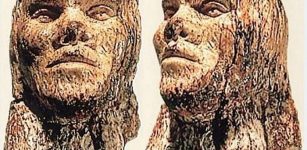Glorious And Scary Orava Castle – Realms Of Nosferatu And A Historical Landmark Of Slovakia
Jan Bartek – AncientPages.com - Glorious and scary Orava Castle is often associated with the realms of Nosferatu today, but the history of this ancient building goes much further in time.
Orava Castle. Credit - Wojsyl, CC BY-SA 3.0
In 1922, when the horror movie Nosferatu was shot, it was decided to use the castle as the residence of the legendary vampire. It was a good choice because Orva Castle has all the spooky elements required in a scary vampire movie.
Nicknamed the "Dracula Castle," the magnificent ancient castle is situated on a high rock above the Orava River in Oravský Podzámok, Slovakia, a territory as early as the Primeval Age.
Orava Castle Is Much More Than The Home Of Nosferatu
Many people see little or no distinction between Czechs and Slovaks, which is perfectly understandable because it wasn't so long ago that we used the name Czechoslovakia. People of both countries lived together in a single state.
Still, though these two countries have many cultural similarities, there are also several significant differences.
With its scary atmosphere and mysterious underground passages, the Orava Castle attracts many tourists who want to enjoy and admire this tremendous historical landmark of Slovakia.
Some people who visit the Orava Castle ask if this place was the home of the horrifying, bloodthirsty vampire, but after learning the truth, they tend to be a little disappointed.
The surrounding atmosphere makes the Orava Castle look remarkable. Image credit: Orava Castle Museum
To begin with, one must remember Nosferatu was only a movie character.
Count Dracula existed and was often cruel, but he wasn't a vampire. His real name was Vlad III, but he was often called Dracula, and he was a Prince in Wallachia, a part of present-day southern Romania, who lived between 1431 and 1476.
Vlad used severe methods to restore order in a lawless state. He also dared to drive the occupation force, the Ottomans, out of the country. But Vlad had a dark side, too.
Regarded today as a national hero, Vlad III most likely inspired the Irish author Bram Stoker, who "borrowed Vlad's name for his Transylvanian count in the book "Dracula" from 1897. We have to remember that 'Dracula' is literally translated in Gaelic as Drac Ullah, which means 'bad blood.'" 1
Its old age is visible. Image credit: Orava Castle Museum
Orava Castle Was Almost Erased From Ancient History Pages
The ancient past of the Orava Castle is also fascinating, especially since the beautiful building was almost erased from the history pages.
After the Tartar invasion in 1241, people started to build the castle on an old wooden fortification site. It took several centuries, but the castle grew in size in time thanks to several owners who reconstructed it.
The original design of 'Dracula Castle' was in Romanesque and Gothic style, but later it was reconstructed as a Renaissance and Neo-Gothic structure. In the mid-16th century, the Thurzo House, a Hungarian noble family, invested in the Orava Castle and turned it into a magnificent building, but its present form was not finalized until 1611.
After the death of the last descendant of the Thurzo family, the castle had several owners, but they didn't bother to invest in the maintenance of the building. Then, in 1800, a tragic fire destroyed the Orava Castle, and its owners could no longer use it as a residence.
Entering through this door gives you the impression you're visiting a different world. Image credit: Orava Castle Museum
When World War I and II broke out, it was evident that no one had time to think about this ancient castle. At this point, it seemed Orva Castle was not meant to be, but fortunately, restoration work started again after WW II and the castle became a national monument. Orva Castle survived against all odds.
With its 154 rooms, 754 stairs, palaces, towers, and underground passages, it's difficult to say what part of the Orava Castle is most interesting. The beautiful Chapel of St. Michael and the Knights' Room are attractive places to explore among visitors.
To many, this will always be Dracula's Castle. Still, putting fascination with Nosferatu and blood-sucking vampires aside, we should never forget that Orava Castle commemorates many historical events and movements that had a decisive impact on the fate of Slovakia.
Written by Jan Bartek - AncientPages.com Staff Writer
Updated on Nov 21, 2023
Copyright © AncientPages.com All rights reserved. This material may not be published, broadcast, rewritten or redistributed in whole or part without the express written permission of AncientPages.com
Expand for referencesJ. Podolak. "The Development of Ethnography in Slovakia." Midwest Folklore 8, no. 2 (1958): 69-84. Accessed January 24, 2020.
More From Ancient Pages
-
 Ötzi The Iceman’s Stomach Bacteria And Complex History Of European Settlements
Archaeology | Jan 8, 2016
Ötzi The Iceman’s Stomach Bacteria And Complex History Of European Settlements
Archaeology | Jan 8, 2016 -
 1,200-Year-Old Rock-Cut Temple Found On Banks Of Arjuna River,Tamil Nadu, India
Archaeology | Sep 3, 2020
1,200-Year-Old Rock-Cut Temple Found On Banks Of Arjuna River,Tamil Nadu, India
Archaeology | Sep 3, 2020 -
 Anartes: Forgotten Celtic Tribe And The Hercynian Forest With Strange Animals
Featured Stories | Jun 18, 2024
Anartes: Forgotten Celtic Tribe And The Hercynian Forest With Strange Animals
Featured Stories | Jun 18, 2024 -
 Ife Head: Significance Of The Head ‘Ori’ In Yoruba Ancient And Present Beliefs
Artifacts | Mar 27, 2019
Ife Head: Significance Of The Head ‘Ori’ In Yoruba Ancient And Present Beliefs
Artifacts | Mar 27, 2019 -
 15,000-Year-Old Shell Beads Found Kebara Cave Are The Oldest Known Use Of Organic Red Pigments
Archaeology | Oct 27, 2023
15,000-Year-Old Shell Beads Found Kebara Cave Are The Oldest Known Use Of Organic Red Pigments
Archaeology | Oct 27, 2023 -
 On This Day In History: Viking Forces Laid Siege To Paris – On Nov 25, 885
News | Nov 25, 2016
On This Day In History: Viking Forces Laid Siege To Paris – On Nov 25, 885
News | Nov 25, 2016 -
 Mesoamerican Rubber Ball Game Tradition Existed Earlier Than Thought
Ancient Traditions And Customs | Mar 17, 2020
Mesoamerican Rubber Ball Game Tradition Existed Earlier Than Thought
Ancient Traditions And Customs | Mar 17, 2020 -
 Has The Mystery Of The Lost Trading Ship Zuytdorp Been Solved?
Archaeology | Dec 11, 2024
Has The Mystery Of The Lost Trading Ship Zuytdorp Been Solved?
Archaeology | Dec 11, 2024 -
 Prehistoric Anomaly On The Tennessee-North Carolina Border Baffles Scientists
Featured Stories | Jul 30, 2024
Prehistoric Anomaly On The Tennessee-North Carolina Border Baffles Scientists
Featured Stories | Jul 30, 2024 -
 Ostia Antica – Unique Ancient Harbor City In The Suburbs Of Rome
Civilizations | Nov 29, 2018
Ostia Antica – Unique Ancient Harbor City In The Suburbs Of Rome
Civilizations | Nov 29, 2018 -
 Cooking, Roasting And Eating Of Root Plants Is 120,000-Year-Old Habit
Archaeology | Jun 7, 2019
Cooking, Roasting And Eating Of Root Plants Is 120,000-Year-Old Habit
Archaeology | Jun 7, 2019 -
 Incredible Mammoth Ivory Male Head From Dolni Vestonice, Czech Dated To 26,000 BC
Artifacts | Jun 23, 2015
Incredible Mammoth Ivory Male Head From Dolni Vestonice, Czech Dated To 26,000 BC
Artifacts | Jun 23, 2015 -
 2,000-Year Old Engraved Kurdistan Tablet Referring To A Hellenistic Ruler Demetrius – Analyzed
Archaeology | Dec 14, 2020
2,000-Year Old Engraved Kurdistan Tablet Referring To A Hellenistic Ruler Demetrius – Analyzed
Archaeology | Dec 14, 2020 -
 Unexplained Phenomenon In Ancient Ireland – When Legends, Science And Real Events Collide
Ancient Mysteries | Apr 19, 2018
Unexplained Phenomenon In Ancient Ireland – When Legends, Science And Real Events Collide
Ancient Mysteries | Apr 19, 2018 -
 Raijin: Shinto God Of Thunder And Lightning With Three Fingers Representing Past, Present And Future
Featured Stories | Feb 10, 2020
Raijin: Shinto God Of Thunder And Lightning With Three Fingers Representing Past, Present And Future
Featured Stories | Feb 10, 2020 -
 What Was An Aztec Confession?
Ancient History Facts | Jul 25, 2017
What Was An Aztec Confession?
Ancient History Facts | Jul 25, 2017 -
 Scientists Found Mysterious Prophecies In Ancient Egyptian Pyramid – Are They Linked To The Strange Visions Some Experience Inside?
Featured Stories | Dec 17, 2024
Scientists Found Mysterious Prophecies In Ancient Egyptian Pyramid – Are They Linked To The Strange Visions Some Experience Inside?
Featured Stories | Dec 17, 2024 -
 America’s Mysterious Pedro Mountain Mummy And The Hidden Race Of Little People
Featured Stories | Jul 3, 2014
America’s Mysterious Pedro Mountain Mummy And The Hidden Race Of Little People
Featured Stories | Jul 3, 2014 -
 Maya Site With At Least 300 Buildings Some Of Which Are Over 8 Meters High – Discovered
Archaeology | Sep 16, 2022
Maya Site With At Least 300 Buildings Some Of Which Are Over 8 Meters High – Discovered
Archaeology | Sep 16, 2022 -
 3D Scan Will Uncover Secrets Of The Magnificent Vindelev Gold Treasure
Archaeology | Oct 25, 2023
3D Scan Will Uncover Secrets Of The Magnificent Vindelev Gold Treasure
Archaeology | Oct 25, 2023





